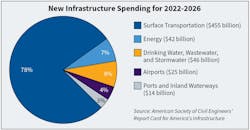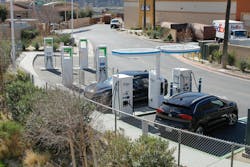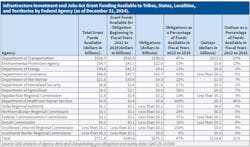Key Takeaways
- The IIJA and IRA collectively allocate over $700 billion for infrastructure, but their rollout has been hampered by administrative delays and policy reviews.
- Key sectors like EV charging, broadband, and energy projects face slow progress due to funding pauses, executive orders, and legislative uncertainties.
- Legal challenges and executive orders have created a fog of uncertainty, affecting project planning and investment decisions across the industry.
- Despite these hurdles, the 2021 legislation has helped improve the nation's infrastructure grade, but a significant investment gap remains, requiring sustained support beyond 2026.
Persistent worries about the state of the nation’s infrastructure now have another wrinkle: mounting debate about what’s worthy of taxpayer support and concerns over how fast that money is getting out the door. Under the new Trump administration, the Infrastructure Investment and Jobs Act (IIJA), passed in 2021 to direct more than $700 billion in grants to fund a wide array of infrastructure programs over five years (Fig. 1), has come under some scrutiny. Likewise, parts of the Inflation Reduction Act (IRA), which in 2022 put a similar amount toward infrastructure over time, are being looked at.
Included in the crosshairs of administration actions — executive orders, agency rulings, and Congressional committee oversight seeking to pause outlays in targeted programs pending review — is infrastructure spending that the electrical contracting and design engineering industry covets. This includes projects related to electric vehicle charging, renewable energy generation, broadband deployment, energy resilience, and virtually anything related to climate change remediation.
Independent of the Trump-induced speed bump, a slow rollout of other IIJA and IRA spending through the Departments of Energy (DOE) and Transportation (DOT), such as that for power transmission and distribution, water, and airports, for example, continues to impact firms and their hopes for an infrastructure spending windfall.
A halting rollout
Ken Simonson, chief economist for Associated General Contractors (AGC), calls the IIJA a “mixed bag” in terms of fulfilling its promise. Contractors are reaping comparatively more benefits from spending on hard infrastructure like water systems, airports, and roads, he says, some of the top “new investment” targets identified by the American Society of Civil Engineers (ASCE), as shown in Fig. 2. But others that breed more controversy (like broadband expansion and energy) are lagging.
“‘Unclear’ is the best adjective when it comes to the IIJA,” he says. “There have been a lot of announcements of things stopped, but it’s not clear how many of them continue to be under review or have been cancelled.”
There’s evidence that worry over the fate of funding has been growing. The most recent quarterly business sentiment survey, conducted by the American Council of Engineering Companies (ACEC) through its members, shows 41% think a slow rollout of the IIJA will be a contributor to negative economic sentiment a year from now. It doesn’t rank high on the list of potentially impactful factors, but the share has grown steadily since the third quarter of 2024 (when it stood at 26%).
A new round of delays in getting funding out the door is a legitimate worry, says Matt Reiffer, vice president of infrastructure programs for ACEC. While noting new administrations with different priorities typically cause hiccups in programs, he acknowledges that “the pace and scale of change in 2025 has been unprecedented, adding, “executive orders and agency directives have changed areas of emphasis and prioritization, impacting grant criteria and project selection.”
The result, he says, is that his membership, while confident that markets boosted by federal infrastructure dollars will ultimately deliver, must prepare itself for changes that the spending reviews could spawn.
“The potential disruption from changes in prioritization, particularly in the energy sector and projects related to climate adaptation and resilience, should prompt firms to review and consider diversifying their business plans,” he says.
EV charging whipsaw
Firms in the electrical services space that were counting on the IIJA to deliver opportunity in the buildout of electric vehicle charging infrastructure have had a front row seat to the shifting winds of policy formulation and execution.
The IIJA authorized and appropriated $7.5 billion for programs to support the deployment of public EV charging infrastructure. One was the DOT’s National Electrical Vehicle Infrastructure (NEVI) Formula program, given $1 billion annually through 2026 to assist states in that effort.
NEVI was slow out of the blocks, however, and has not picked up speed. A July 2025 Government Accountability Office (GAO) report to Congress on EV infrastructure stated that, as of April 2025, only 384 chargers funded through NEVI and another IIJA program were open to the public. While not passing judgement on that number, GAO noted its report was motivated by concerns Congress had expressed “over the pace at which charging ports have been built under the NEVI and CFI (Charging and Fueling Infrastructure Discretionary Grant Program).”
Already struggling, the programs took another hit in January, when Trump issued an executive order halting the disbursement of a broad swath of IIJA funding tied to alternative energy development. Both were affected, leading the Federal Highway Administration (FHWA) to begin a review of them to ensure they aligned with administration policies and priorities. Soon after, FHWA informed states that it was rescinding current and prior versions of its program guidance. The GAO report noted, too, that the administration’s FY 2026 budget was cancelling $6 billion in funds for EV charger programs.
Now, though, the programs are back up. In mid-August, DOT said following a review, it was unveiling revised guidance aimed at freeing up the 84% of IIJA funding that remains unobligated. That will be achieved by giving states more flexibility, cutting red tape, and updating streamlined applications. In line with the administration’s priorities, the guidance moves the program away from tying funding to the promotion of diversity/equity/inclusion (DEI), which the administration opposes. DOT says the overhaul will “ensure charging stations are actually built, and federal funding is spent effectively and efficiently.”
Such administration fine-tuning of IIJA programs could still be in the early stages. Many agencies are still getting their footing and are dealing with reduced staffing levels and changes in priorities fostered in part by actions of the Department of Government Efficiency, and that could affect whether and how fast money gets out the door.
Additionally, the Republican-controlled Congress is expected to enter the fray, taking up legislative responsibilities relating to IIJA reauthorization and proposals to alter the mechanics of the funding. Of some potential consequence, Reiffer says, are appropriations bills that could “redirect some portions of advanced funding under the IIJA into regular agency program budgets, essentially eliminating the supplemental nature of the funding.”
GAO lifts the hood
Whether actions by the administration will slow or speed up IIJA funding, the pace is already slow by some measures in many agencies. In an April report to Congress, GAO said that as of year-end 2024, $275 billion of the $581 billion (82% of the total $712 billion authorized) made available to federal agencies for infrastructure projects through fiscal year 2025 had been obligated. Outlays, the amount actually handed over, totaled just $119 billion or 21% (see Table).
At DOT, by far the largest single recipient of IIJA funding, obligated funding as of July 31 totaled $305 billion, 71% of its $432 billion budget authority. But the total outlay at that date was $169 billion or 39%. Money for roads, bridges, tunnels, etc., has been obligated and outlaid at the quickest pace, around 80% and 50% to 60%, respectively, across agencies like the Federal Highway Administration and the Federal Motor Carrier Safety Administration.
Other DOT sub-agencies are lagging. Federal Aviation Administration dollars, for projects that may impact electrical design and contracting firms more than others under DOT, are going out more slowly. Of its $20 billion authority, 51% had been obligated and 27% outlayed as of late July. Federal Railroad Administration projects, which can also incorporate heavy electrical, are slow as well. IIJA funding authority was $53 billion, 65% of which was obligated, and only 8% outlayed.
GAO issued a report in July urging DOT to address delays in getting funding to discretionary grant awardees. The sources of the delays include inflation-linked cost increases; conforming to the Build America, Buy America Act; National Environmental Policy Act reviews; and defining project budget and scheduling. These interrelated challenges, GAO said, “create risks for awardees, including that funding will expire or no longer be available to the awardee,” adding “awardee challenges need to be addressed as it makes decisions about delivering the remaining billions in IIJA funding.”
At DOE, the agency shepherding IIJA projects with the most potential for the electrical sector, obligations and outlays as a percentage of total authority is the lowest of some 15 agencies. Of almost $43 billion in funds available for obligation for FY 2022-2025, the agency obligated 11% and outlayed just 1% as of year-end 2024. The lagging performance may be due in part, GAO says, to the agency being one of three that have never drafted an IIJA implementation plan. DOE attributed it partly to decentralized management plans that never developed cohesive implementation guidance.
Targeting “green”
Prospects for DOE quickening the pace have dimmed. With executive orders and agency directives, the administration has put a bullseye on energy projects that smack of “green,” a significant component of IIJA’s energy infrastructure focus. Trump’s “Unleashing American Energy” executive order (prioritizing traditional energy sources) froze non-conforming IIJA outlays. Though quickly narrowed in scope by the Office of Management and Budget, and subsequently partly reversed by a U.S. District Court judge, the order may be casting a pall over IIJA funding that goes through the DOE to many energy projects, meaning the funding backlog could remain slow to clear.
Even though Trump’s executive orders have been reversed on challenge, some of which were appealed by agencies, they did prompt lawsuits questioning the executive branch’s authority to block Congressionally approved funding. Their outcome, Reiffer says, could have some bearing on the fate of energy project loans through IIJA and grantees awarded funds that were paused or withdrawn. Overall, “we don’t expect a significant impact on most programs” from the suits; Congress, he added, will also “have a significant role in defining how funds are allocated and overseeing how they are spent.”
The fog of uncertainty surrounding the IIJA is enveloping organizations with a financial stake in prospective spending. Centre Law & Consulting, Tysons, Va., is representing developers, contractors, and others that have made financial and contractual commitments to possibly ill-fated IIJA projects. Business has been predictably brisk, says Managing Partner Barbara Kinosky, because the level of exposure to financial harm from possibly billions of dollars of yanked or slowed funding is high.
Many of Centre Law’s clients find themselves in a fix. Many have spent heavily on proposals, staff, equipment, or other resources to deliver on signed or prospective contracts for IIJA-funded projects. With uncertainty swirling, Kinosky says, they can be in a quandary about whether to pull the plug and seek compensation for cancelled contracts through litigation or negotiation — or wait to see if projects under review ultimately receive funding and move forward.
“We had one client that made a decision to get out, and then two weeks later the termination was rescinded,” she says. “You end up not knowing whether to go full bore or not.”
The infrastructure gap
A lack of clarity on individual project funding, administration commitment to spending appropriated money, and the continuation of comprehensive infrastructure legislation come at what may be a critical juncture.
The nation’s infrastructure, says the ASCE in its newest Report Card for America’s Infrastructure, faces a “substantial investment gap.” Over the next decade, $9.1 trillion will have to be spent if 18 categories of infrastructure are to reach a “state of good repair.” But it puts public and private investment at $5.4 trillion, assuming current funding levels are maintained, leaving a gap of $3.7 trillion. And that gap would grow “significantly if Congress were to snap back investment levels in place prior to recent increases in federal spending.”
The report card, which gives the nation’s infrastructure a grade of “C,” (mediocre/requires attention) up from a “C-” in 2021, credits the IIJA and the IRA with helping to boost that grade. But the true power in that legislation will come from its continuation in some meaningful form.
“The IIJA and Inflation Reduction Act’s $580 billion in new investment has provided an initial and consequential step in bridging the funding gap between the nation’s infrastructure needs and preexisting support,” ASCE says. “We must sustain, or in many cases, increase, infrastructure funding and financing options across all levels of government and the private sector,” and “Congress should maintain investment levels provided by the IIJA when the law expires in 2026 and fully fund authorized programs during the annual appropriations process.
About the Author
Tom Zind
Freelance Writer
Zind is a freelance writer based in Lee’s Summit, Mo. He can be reached at [email protected].





